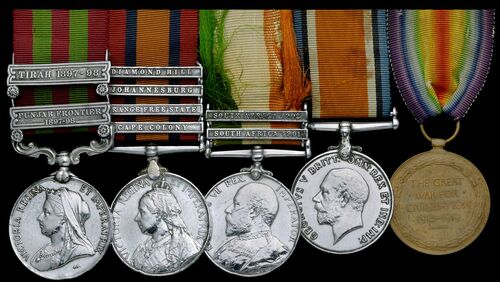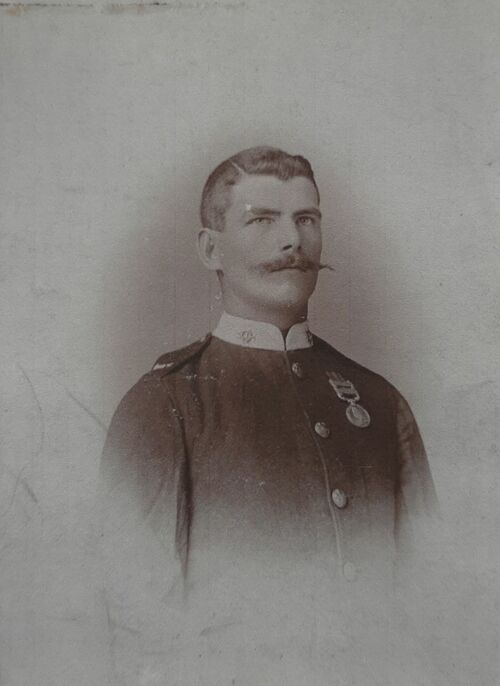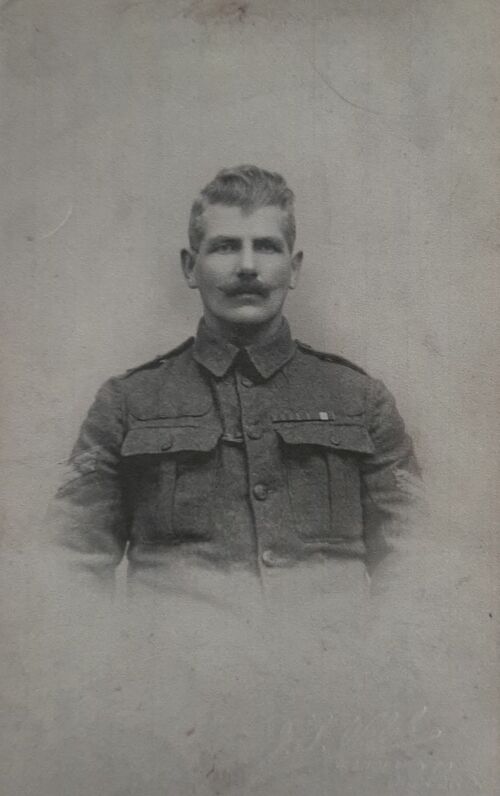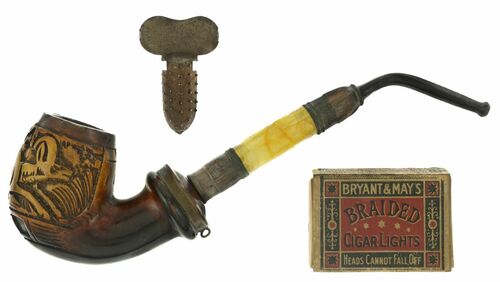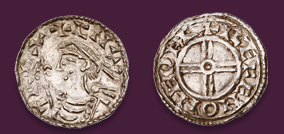Auction: 23111 - Orders, Decorations and Medals - e-Auction
Lot: 544
An unusual Boer War 'hand-to-hand struggle M.I.D.' group of five awarded to Colour-Sergeant G. G. Sanderson, Nottinghamshire and Derbyshire Regiment, later West Yorkshire Regiment, who was personally promoted by Lord Kitchener after his heroics at Magaliesberg, later 'mentioned' again during the Great War
India General Service 1895-1908, 2 clasps, Punjab Frontier 1897-98; Tirah 1897-98 (4688 Pte. G. Sanderson. 2d Bn. Derby Regt.); Queen's South Africa 1899-1902, 4 clasps, Cape Colony, Orange Free State, Johannesburg, Diamond Hill (4688 Pte. G. Sanderson. Derby: Regt.); Kings South Africa 1901-02, 2 clasps, South Africa 1901, South Africa 1902 (4688 Pte. G. Sanderson. Notts: & Derby. Regt; British War and Victory Medals (265468 A.C.Sjt. G. Sanderson. W. York. R.), mounted as worn, sold together with a small archive including a pipe reputed to be a gift from Lord Kitchener, heavy edge bruising and contact wear, suspension repaired on second and fourth, overall good fine (5)
George Garibaldi Sanderson was born at St. Johns, Chesterfield, Derbyshire and worked as a miner prior to enlisting with the Derbyshire Regiment at Dublin on 15 June 1894. Posted to the 1st Battalion he served with them until 28 December 1895 when he joined the 2nd Battalion in India. While here Sanderson saw action on the North-West Frontier, being involved in the Tirah Expedition on 1897-98.
Joining the 1st Battalion in Malta on 4 November 1895 he was still with them when they were posted to South Africa on 21 November 1899. They arrived too late to take part in the Battle of Stormberg but did good work during the advance through the Orange Free State and later seeing action at Doornkop. They saw further action at Diamond Hill though were not at the forefront of the fighting there.
Remaining in South Africa for the Guerrilla phase of the war the Battalion saw fighting with the British Columns. They were part of Colonel Kekewich's force attempting to secure the Magaliesberg mountains and came under particularly heavy attack at Moedwill. Kitchener's dispatch highlighted the conduct of the Derbyshire Regiment, stating:
'To give some idea of the severity of the fire to which the troops were subjected, it may be mentioned that three picquets were practically annihilated, and that out of a party of 12 men of the Derbyshire Regiment which was guarding a drift, 8 men were killed and 4 wounded. Upon Colonel Kekewich being incapacitated by wounds the command of the column was temporarily assumed by Lieutenant Colonel Wylly, Derbyshire Regiment'
It was around this time that Kitchener apparently encountered Sanderson. Promoting him personally to Corporal 'for gallantry in the field' on 10 September and making mentioning him in his dispatch stating:
'Lance-Sgts. Bailey, Coxon, Ptes. Boyle, Sanderson; chiefly instrumental in 50 captures made by their company in a week's work in the Magaliesberg; Sanderson held up twenty-four men practically single-handed'.
By family repute Kitchener spoke personally to Sanderson after the fighting. The young private complained of damage caused to his pipe in the melee which Kitchener- a fellow smoker- was sympathetic about. Several days later an antique pipe was delivered to Sanderson with a note presenting the General's compliments.
Returning to Britain on 15 September 1902 Sanderson was transferred to the Army Reserve on 15 October. Discharged entirely on 12 June 1910 he returned to the colours on the outbreak of the Great War. Embodied for service with the 7th Battalion, West Yorkshire Regiment on 12 August 1914 he was promoted back to Corporal the same day. Further advanced Sergeant on 9 August 1915.
Entering the war in France on 8 January 1917 he served there first with 2/7th Battalion although he was later attached to 10th Battalion. Three days before this transfer he received another 'mention' (London Gazette 7 November 1917 refers). Promoted Colour Quartermaster-Sergeant on 11 November 1917 he was to serve in this rank for some time. Unfortunately he was by this time well over forty and the strain of the war clearly had an effect. He was transferred to the Labour Corps as a Sergeant on 15 July 1918 and served with them for the rest of the war. Returning home on 21 November he was transferred to the reserve just two days later. His address upon demobilisation was noted as 12 Garrett Grove, Dewsbury Road, Leeds; sold together with an archive including:
i)
The pipe said to have been awarded to the recipient by Lord Kitchener.
ii)
A file or research relating to the above as well as scanned images of his 'mention'.
iii)
An original copy of the South Africa War 'Mentioned in Despatches' book, this signed by Major- later General- P. E. F. Hobbs.
iv)
Copied service papers.
v)
Handwritten notes.
Subject to 20% VAT on Buyer’s Premium. For more information please view Terms and Conditions for Buyers.
Sold for
£700
Starting price
£280

